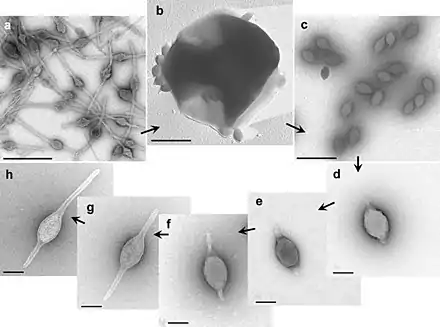Bicaudaviridae
Bicaudaviridae ist die offizielle Bezeichnung einer Familie von Viren mit Doppelstrang-DNA-Genom. Ihre natürlichen Wirte sind hyperthermophile Archaeen der Familie Sulfolobaceae [en] im Phylum Crenarchaeota (mit Gattungen Acidianus [en], Sulfolobus [en], evtl. Saccharolobus [en])[Anm. 1] Derzeit (Stand Mitte März 2021) gibt es in der Familie Bicaudaviridae vom International Committee on Taxonomy of Viruses (ICTV) bestätigt nur die eine Gattung Bicaudavirus mit der Typusart Acidianus two-tailed virus (ATV).[2][3][1]
| Bicaudaviridae | ||||||||||||||||
|---|---|---|---|---|---|---|---|---|---|---|---|---|---|---|---|---|

Bicaudavirus | ||||||||||||||||
| Systematik | ||||||||||||||||
| ||||||||||||||||
| Taxonomische Merkmale | ||||||||||||||||
| ||||||||||||||||
| Wissenschaftlicher Name | ||||||||||||||||
| Bicaudaviridae | ||||||||||||||||
| Links | ||||||||||||||||
|
Der Name leitet sich ab von den lateinischen Wörtern bi und cauda ab, was so viel wie Zweischwanz oder Doppelschwanz bedeutet.
Aufbau
Die Virionen (Virusteilchen) der Bicaudaviridae sind möglicherweise umhüllt und haben eine zitronenförmige Geometrie. Das Genom ist unsegmentiert (monopartit) und besteht aus einem zirkulär geschlossenen dsDNA-Molekül mit einer Länge von etwa 62 kbp (Kilobasenpaaren). Es hat 72 offene Leserahmen (en. open reading frames, ORFs).[3]
Reproduktionszyklus

Die Reproduktion der Viren erfolgt im Zytoplasma der Wirtszellen. Der Eintritt in die Wirtszelle (Infektion) erfolgt durch Anlagerung der Virus-Proteine an Wirtsrezeptoren, wodurch eine Endozytose vermittelt wird. Die Virus-DNA dient als Vorlage für die Transkription (en. DNA-templated transcription). Der Austritt aus der Wirtszelle erfolgt durch Knospung (en. budding). Die Übertragung der Virusteilchen geschieht durch passive Diffusion.[3]
Forschungsgeschichte
Die Familie Bicaudaviridae wurde erstmals von dem Team um D. Prangishvili im Jahr 2005 beschrieben.[4][5]
Systematik
Die Systematik ist nach ICTV (Master Species List #35: Offiziell anerkannte Taxa)[1] und National Center for Biotechnology Information (NCBI – Vorschläge, in doppelten Anführungszeichen)[6][7] mit Stand Mitte März 2021 wie folgt:
Gruppe: dsDNA (Baltimore: 1)
Familie: Bicaudaviridae
- Gattung: Bicaudavirus
- Gattung „Betabicaudavirus“[10]
- Spezies: „Sulfolobus-Virus STSV1“ (englisch „Sulfolobus virus STSV1“ alias „Sulfolobus tengchongensis spindle-shaped virus 1“, STSV1)[11]
- Spezies: „Sulfolobus virus STSV2“ (en. „Sulfolobus virus STSV2“ alias „Sulfolobus tengchongensis spindle-shaped virus 2“, STSV2)[12]
- ohne Gattungszuordnung:
- Spezies: „Acidianus tailed spindle virus“ (ATSV)
- Spezies: „Sulfolobus monocaudavirus SMV1“ (SMV1)
- Spezies: „Sulfolobus monocaudavirus SMV2“ (SMV2)
- Spezies: „Sulfolobus monocaudavirus SMV3“ (SMV3)
- Spezies: „Sulfolobus monocaudavirus SMV4“ (SMV4)
Die beiden vorgeschlagenen Species STSV1 und STSV2 sind wohl zu unterscheiden von den beiden ICTV-bestätigten Spezies
der Gattung Alphafusellovirus in der Familie Fuselloviridae.
Anmerkungen
- Einige Gattungen von Sulfolobus (offenbar aber nicht S. tengchongensis) wurden in neuerer Zeit nach Saccharolobus verschoben:
- LPSN: Saccharolobus, Sulfolobus, S. shibatae, S. solfataricus
- Hiroyuki D. Sakai, Norio Kurosawa: Saccharolobus caldissimus gen. nov., sp. nov., a facultatively anaerobic iron-reducing hyperthermophilic archaeon isolated from an acidic terrestrial hot spring, and reclassification of Sulfolobus solfataricus as Saccharolobus solfataricus comb. nov. and Sulfolobus shibatae as Saccharolobus shibatae comb. nov, in: Int J Syst Evol Microbiol 68(4), April 2018, S. 1271–1278, Epub 27. Februar 2018, doi:10.1099/ijsem.0.002665, PMID 29485400
- Anh Le-Cook, James Musser: Sulfolobus/Saccharolobus, Extreme Viruses Lab (Stedman Lab)
Einzelnachweise
- ICTV: ICTV Master Species List 2019.v1, New MSL including all taxa updates since the 2018b release, March 2020 (MSL #35)
- D Prangishvili, M Krupovic, ICTV Report Consortium: ICTV Virus Taxonomy Profile: Bicaudaviridae. In: The Journal of General Virology. 99, Nr. 7, 7. Juni 2018, S. 864–865. doi:10.1099/jgv.0.001106. PMID 29877786.
- Viral Zone. ExPASy. Abgerufen am 18. März 2021.
- Häring M, Vestergaard G, Rachel R, Chen L, Garrett RA and Prangishvili D (2005) Independent virus development outside a host. Nature 436, 1101–1102
- Prangishvili, D., Vestergaard G, Häring M, Aramayo R, Basta T, Rachel R and Garrett RA (2006) Structural and genomic properties of the hyperthermophilic archaeal virus ATV with an extracellular stage of the reproductive cycle. J. Mol. Biol. 359, S. 1203–1216
- NCBI: Bicaudaviridae (family)
- Andrew M. Kropinski, Stuart G. Siddell: ICTV: ICTV Report Bicaudaviridae, Mai 2018
- NCBI: Acidianus two-tailed virus 2 (species)
- NCBI: Acidianus two-tailed virus variant 1 (species)
- M Krupovic, ER Quemin, DH Bamford, P Forterre, D Prangishvili: Unification of the globally distributed spindle-shaped viruses of the Archaea. In: Journal of Virology. 88, Nr. 4, 2014, S. 2354–8. doi:10.1128/JVI.02941-13. PMID 24335300. PMC 3911535 (freier Volltext).
- NCBI: Sulfolobus virus STSV1 (unclassified species)
- NCBI: Sulfolobus virus STSV2 (unclassified species)
- NCBI: Sulfolobus spindle-shaped virus 1 (ICTV accepte species)
- NCBI: Sulfolobus spindle-shaped virus 2 (ICTV accepte species)